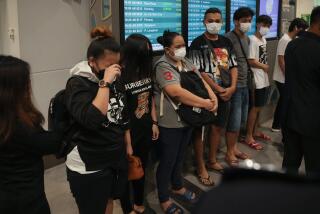Student Guns Down 3 Professors in Arizona
A failing student gunned down and killed three of his nursing professors at the University of Arizona on Monday morning, calmly opening fire on two of them in front of a roomful of horrified exam-takers, police said. The gunman then ordered the students out of the classroom and committed suicide.
More than 20 students witnessed two of the shootings, some of them hiding under desks while others fled the fourth-floor classroom, screaming and sobbing, police said.
“We were taking a critical-care exam. We were halfway through it,” said Julie Raymond, 22, a senior nursing student. “I didn’t pay any attention until he started talking. He fired shots and told us all to leave. I thought it was a joke at first, a really bad Halloween joke.”
Raymond said she realized it wasn’t a prank when “I heard the gun.”
Police identified the gunman as Robert S. Flores, 41, a Persian Gulf War veteran and student at the College of Nursing. Flores had failed a pediatric nursing class and was struggling in the critical-care class, according to Elizabeth Irvin, the university’s vice provost.
Police arrived at the campus three minutes after the 8:40 a.m. report of gunfire and quickly summoned the bomb squad after a package or backpack was discovered under the gunman’s body. A bomb-sniffing dog also alerted officers to possible traces of explosives in Flores’ car.
The nursing school and nearby buildings were evacuated. Police searched into the evening but no explosives were found in the building or in Flores’ vehicle.
In a late briefing, police said the suspect was carrying five handguns and at least 200 rounds of ammunition.
After the shooting, bomb squad investigators ordered residents of the apartment complex where Flores lived to leave their homes, but a check of his apartment found no explosives. A witness had told police that Flores had made a bomb threat two weeks earlier against the College of Nursing, Tucson Police Chief Richard Miranda said.
The victims were identified as Robin Rogers, 50, who was shot first and whose body was discovered in her second-floor office in the nursing school building; Barbara Monroe, 45, shot three times in the front of the classroom; and Cheryl McGaffic, 44, the final victim, shot three times in the rear of the room. All three were associate professors of nursing.
McGaffic “was a spiritual person,” said Megan Fernow, 21, a nursing student. “At student orientation this year, she said if you have a problem in spirituality, come to me.”
Lindsay Edwards, 21, a psychology major, was waiting for a shuttle bus when she saw a crying student run out of the building.
The student said two professors had been shot. Edwards said witnesses told her some of the critical-care students were so upset they were throwing up.
Joe Brink, manager of the apartment complex, said Flores never had a harsh word about anyone and was easily recognized as the owner of a Great Dane that he walked each morning.
Brink said that Flores’ 15-year-old daughter and 10-year-old son visited during the summer and on weekends, and that he never saw any firearms when he was inside Flores’ apartment.
“I enjoyed talking with him very much,” the manager said. “He was always concerned about my health. He was concerned about everybody.”
Miranda said Flores had targeted his victims.
“It’s too soon to say why he committed this terrible deed,” Miranda said. “We have determined that there are many issues in Mr. Flores’ life, all of which are a factor.”
Miranda said that in April someone from the university had “made a report” to the police about Flores, saying he was depressed and might do something to harm others. The chief declined to elaborate.
Describing the scene in Room 467, nursing student Diana Lugo, 22, told the Arizona Daily Star: “He walked in and said to the first professor, ‘Here’s a lesson in spirituality,’ then he said, ‘Make peace with your maker,’ and then he shot her.”
Police said he worked at the Southern Arizona Veterans Affairs Health Care System as a licensed practical nurse and was studying to become a registered nurse.
Violence has occurred at several American colleges over the last decade, though claiming fewer victims.
In 1992, an 18-year-old sophomore wearing a shirt with the words “Sick of it all” in red letters went on a shooting rampage at Simon’s Rock College of Bard in Great Barrington, Mass., killing a teacher and a student and wounding four other people.
Three years later, a Harvard premed student fatally stabbed a classmate and wounded the woman’s friend before taking her own life.
On the first day of classes in August 2000, a 67-year-old English professor at the University of Arkansas was gunned down in his office by a longtime graduate student, who then killed himself. The student had just been notified that he had been dropped from the graduate comparative literature program for insufficient academic progress.
In January, a student apparently irate over failing grades killed the dean, a professor and another student at Appalachian School of Law in Grundy, Va.
“We have now seen a number of these kinds of events and usually there is a sign,” said Joel C. Epstein, a lecturer in education law and policy at Boston College who specializes in campus safety issues.
Epstein said college administrators sometimes mistakenly believe they are capable of defusing the problem, not realizing they are facing a potentially deadly situation.
“When you are dealing with someone who is potentially lethal, that is not the way to go,” Epstein said.
“The problem is, communication typically breaks down somewhere between the professor and administrator, who may know of a troubled student, and the rest of the institution.”
*
Times staff writer John J. Goldman in New York contributed to this report.
More to Read
Start your day right
Sign up for Essential California for news, features and recommendations from the L.A. Times and beyond in your inbox six days a week.
You may occasionally receive promotional content from the Los Angeles Times.






